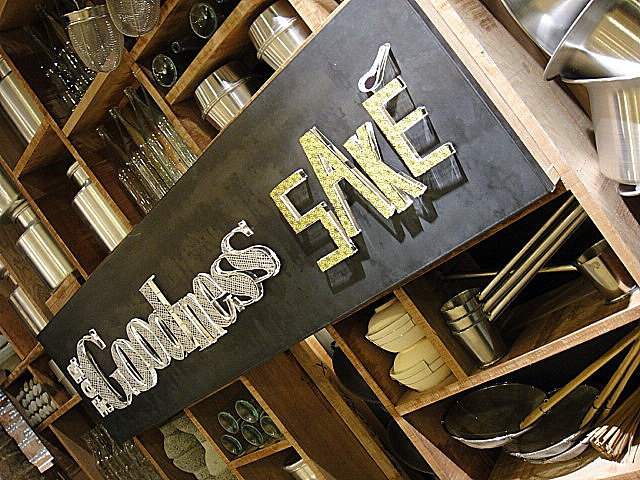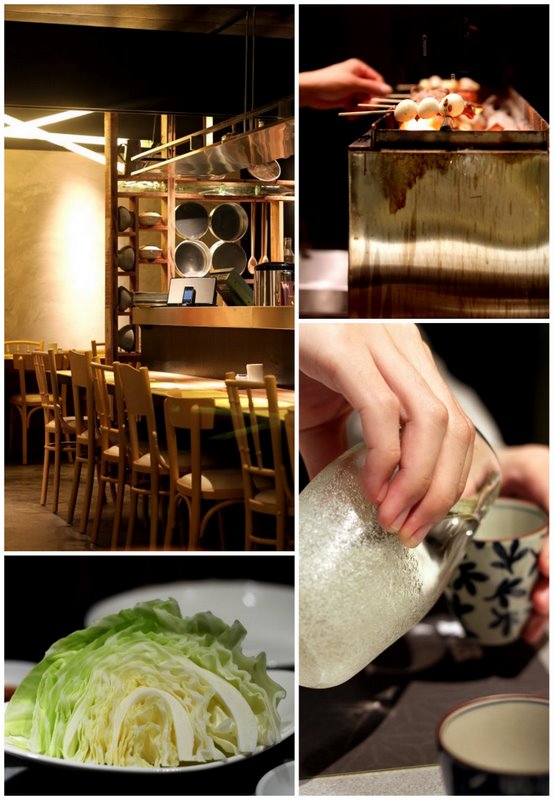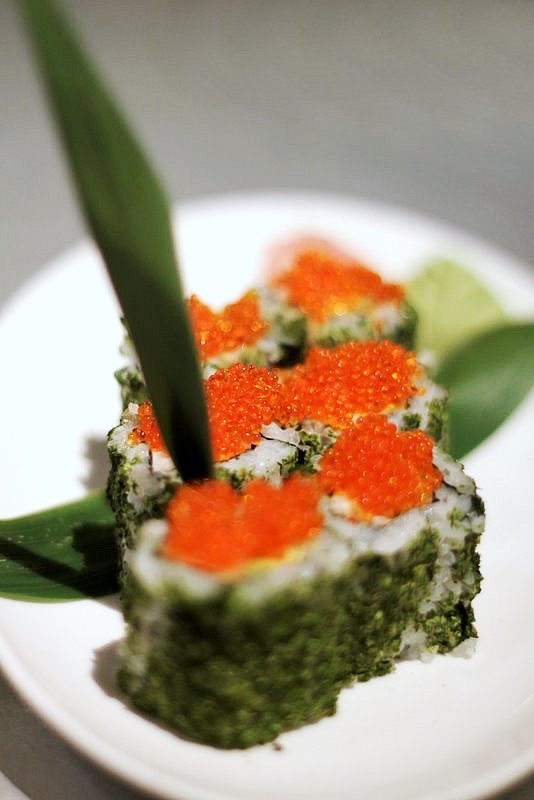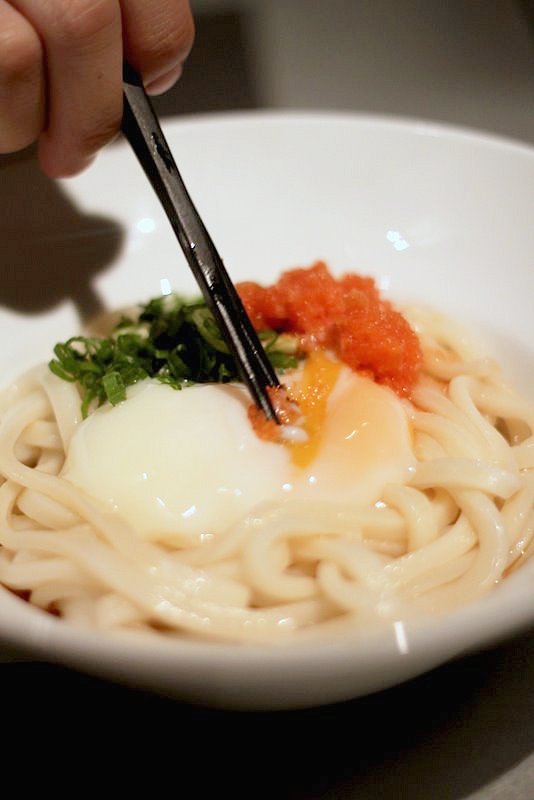NOT a food blog
For Goodness Saké, Bangsar Village II
22Jan2010 Filed under: Food Type: Japanese, Location: Bangsar Author: Lyrical LemongrassSake1 /sayk/
• noun (1)(for the sake of) for the purpose of or in the interest of. (2) (for the sake of) out of consideration for or in order to help. (3) (for old times’ sake) in memory of former times. (4) (for God’s/goodness sake) expressing impatience or desperation.
Saké2 /sä’kē, -kě/
• noun a Japanese alcoholic drink made from fermented rice.
— ORIGIN Japanese.
(Source: The Compact Oxford English Dictionary)
************************
I had arrived early and was standing outside For Goodness Saké while talking on the phone with him.
“Let’s eat at For Goodness Sake (sayk),” I said hesitantly, because it seemed like a strange name for a restaurant. I looked askance at the restaurant waitress.
“For Goodness Saké (sä’kě), ma’am,” she said.
I was still on the phone. “Saké? For Goodness Saké?” I said, to no one in particular.
“Hello?” he was still on the line.
“I’m confused. I’ll call you back.”
After a brief linguistic struggle, I decided that it was a pretty creative name after all. (“Hogwash,” he said, “it’s corny lah!”) For Goodness Saké is the latest addition to the ever growing Ms. Read empire. It doesn’t take a genius to figure out that the restaurant serves Japanese food, with a menu containing simple Japanese bar type fare – small bites, maki, sushi, salads, noodles and robatayaki. Robatayaki (Japanese grill) is only available for dinner, and includes chicken, beef, seafood and vegetables. A selection of sake and wine is also available for consumption.
Sake and yakitori are a great match; salty food generally goes wonderfully with alcohol, but eating the skewered meat was akin to downing a swig of the dead sea. After the initial sucking (a salt-removing ritual that I dreaded each time I picked up a morsel from the plate), the flavour of the meats generally came through. The shisho maki (shisho leaf and beef) and gyu tan (ox tongue) were tender and flavourful. The nan kotsu (soft bone chicken) was too chewy while the reba (chicken liver with teriyaki sauce) came out overcooked. The other items (quail eggs, chicken skin) were not very memorable.
Thankfully, the sucking and chewing process (consumed with lots of green tea and sake) ceased when the saba shioyaki (mackerel with salt) was placed before us. The grilling was perfect, revealing a thin crispy skin and moist immaculately cooked flesh. Intent on filling our stomachs further, we ordered a serving of Maki. The FGS Maki, presumably the house specialty since it bore the name of the restaurant, was a combination of rice, crabstick, avocado and mayo, rolled in ao nori and topped with ebiko. A no-brainer combination but it failed to create any lasting impression on me.
The tagline for the restaurant is “it’s a noodle bar”, so naturally, we weren’t about to walk away without trying their noodles. Our serving of Oroshi Udon came beautifully presented, a quivering poached egg placed on a bed of udon and garnished with spring onions and ebiko. We ate the noodles cold with a Japanese vinaigrette. Simple, filling fare, but again, quite forgettable.
I do like the place, though. The decor is aesthetically pleasing, and the food is reasonably priced making this a great place to visit with your friends when you’re in the mood to down a bottle of sake or two. Service is also attentive.
For Goodness Saké
2F-29A, Bangsar Village II,
No. 2, Jalan Telawi 1, Bangsar Baru, KL.
(Credit: First picture of restaurant exterior courtesy of Sean)
41 Responses to “For Goodness Saké, Bangsar Village II”
Leave a reply
About this blog
Food, for me, is a means to an end and not an end in itself.
Food, for me, represents the love of family, the fellowship of friends, and the community and communality it brings.






gfad
January 22nd, 2010 at 12:39 am
For goodness sake. Farnee. (¬_¬)
All photos taken wif your T90 ar?
gfad
January 22nd, 2010 at 12:43 am
Hubs asked what I was snorting about. I told him, ‘A jap rest called For Goodness Sa-kay.’ He looked at me and asked, ‘For goodness sake?’ ‘No. I said a Jap rest. Called For Goodness Sa-kay.’ Burst into laughter..
Sean
January 22nd, 2010 at 2:10 am
but what if this sparks a trend! imagine an entire row of restaurants at bangsar village with such names … there’s no business like shochu business! coffee, tea, or mee! gnocchi gnocchi, who’s there? burger off! satayfaction guaranteed!!!
Lyrical Lemongrass
January 22nd, 2010 at 2:42 am
Sean: Hehe!! Here Today, Corn Tomorrow! Mary Had a Little Lamb Rack! By the Light of the Silvery Moo!
thenomadGourmand
January 22nd, 2010 at 4:43 am
doesnt quite warrant a visit anytime soon .. mayb whn the food gets better!
Lyrical Lemongrass
January 22nd, 2010 at 6:43 am
TNG: Great place to hang out, though! There are hits n misses.
cumidanciki
January 22nd, 2010 at 6:47 am
for goodness sake .. u didn’t bring MOI?!! 😛 pffft …
keep blogging! am loving it:D
Lyrical Lemongrass
January 22nd, 2010 at 8:04 am
Ciki, u were busy moonshining in Alor Setar. Hehe.
A Lil Fat Monkey
January 22nd, 2010 at 9:22 am
Oh wow! You’re on a roll BFF.
Anymore Ms. Read opening in that mall they better rebrand it as The Delicious Mall! 😛
Love the FGS Maki shot! So vibrant. How you shoot so up close?
unkaleong
January 22nd, 2010 at 9:24 am
Is my membership to the Japanese Food Appreciation club still under review? Hmm….Did I forget to dot the “i’s” or cross the “t’s”? 😉
Lyrical Lemongrass
January 22nd, 2010 at 9:33 am
Munkeyboy: Atcherly got one more coming up – Canoodling. Heh.
Unka: funny u should mention it. We were just talking abt it yesterday. 🙂
lotsofcravings
January 22nd, 2010 at 12:09 pm
another choice in BV!..not to say theres not enuf choices walking out to telawi..
gfad
January 22nd, 2010 at 12:56 pm
Piss check ur spam box. I’m pwetty sure I commented..
babe_kl
January 22nd, 2010 at 2:39 pm
the egg looked so perfectly done and i’m sold 😉
Lyrical Lemongrass
January 22nd, 2010 at 2:43 pm
gfad! Sorry! You’re right, all your comments went into my Spam box. Oh for goodness sake, what’s happening to the internet these days!
lotsofcravings: I’m all for choice. 🙂
babe_kl: hehe. faster go try then. 🙂
gfad
January 22nd, 2010 at 3:00 pm
Re Mezze photos, I suspected you were using dslr. I notice you can usually get the foreground item clear and background blur with a dslr. Don’t know if that can be done with a p&s.
Lyrical Lemongrass
January 22nd, 2010 at 3:04 pm
gfad, there are some canggih manggih p&s now that can do that too, especially those with manual/semi-manual settings/lenses. But still not as good as a DSLR lor. When everything else fails, do post-editing and manually blur the background. teehee. (but quite teruk la, if u dunno how to do it properly)
gfad
January 22nd, 2010 at 3:23 pm
Planning to get the WX1 for its low light capability and new pet mode, that minimizes blur when shooting moving pets. Great for shooting Lamb whilst he runs around the playground in the evening.. 😀
Lyrical Lemongrass
January 22nd, 2010 at 4:28 pm
gfad, your kid is going to grow up traumatised! 😛
Bangsar-bAbE
January 22nd, 2010 at 4:49 pm
Oooooo the saba fish looks so crispy….even from the pic! I guess I’ll skip their skewered items and go for the udon. =)
Lyrical Lemongrass
January 22nd, 2010 at 4:59 pm
BB, yes, it was very good, although I can imagine you very much as a noodles kinda girl!
gfad
January 22nd, 2010 at 5:17 pm
‘Allo.. I’m not going to shoot him running nekkid ler. Nor holding a big ham bone.. 😀
Lyrical Lemongrass
January 22nd, 2010 at 5:20 pm
gfad, talk about cross-border communications. 😀
gfad
January 22nd, 2010 at 5:41 pm
В нашем лесу много медведей.
сделали этого идти в спам-Бен?
Lyrical Lemongrass
January 22nd, 2010 at 6:16 pm
gfad: Несет все мигрировали на север, где меньше деревьев в лесу.
ladyironchef
January 22nd, 2010 at 6:36 pm
for goodness sake is the name right? people are coming up with more and more quirky names. We have a cafe call “Everything with fries”, and another ice cream parlour “Once Upon A Milkshake”
If it’s up to me, the place will be call “Death by Nutella” 😀
SE Teoh
January 22nd, 2010 at 8:35 pm
The oroshi udon looks good. Just like what I’d find here. Good to know that the Japanese food in Malaysia is getting better and better!
gfad
January 23rd, 2010 at 2:53 pm
ради бога, кроме деревьев и спать с медведями.
Lyrical Lemongrass
January 23rd, 2010 at 5:23 pm
ladyironchef: Yes, that’s the name. I’m even more impressed with the names of Singapore cafes….very creative, I must say! Death by Nutella, eh? hehehe….cute!
SE Teoh: Yes, I think that Japanese food in Malaysia has improved quite a bit. But nothing beats the real deal in Japan. 🙂
gfad: Но медведи необходимо найти свою любовь. Смогут ли они найти его в деревья? Помилуйте, женщина, и дать им поесть и дерьмо, как медведи прошлого.
Cheng Yi
January 23rd, 2010 at 5:48 pm
Guffaw sean’s comment is hilarious!
superwilson
January 24th, 2010 at 8:47 am
I want sake! Sake is good! 🙂
Have a nice weekend!
gfad
January 24th, 2010 at 11:34 pm
ne putem opri vorbim despre urşi acum. Să ne întâlnim pentru a cântat Yee! 🙂
Manggy
January 25th, 2010 at 6:28 am
Heh, it is corny lah 🙂 But the food at least looks good 🙂
Lyrical Lemongrass
January 25th, 2010 at 10:57 am
cyi: Yes, he’s quite the funny one.
superwilson: Thanks, Wilson. You too! 🙂
gfad: Yee weerklink met die beer vleis is heerlike inderdaad! Tell me, sal die beer bedien word rou?
Manggy: hahahaha…you sound almost Malaysian!
thule aka leo
January 25th, 2010 at 3:07 pm
so many posts up during my absence?? Had to spend some time reading through them 🙂
Life for Beginners
January 25th, 2010 at 3:32 pm
Howsabout it’s corny AND creative? Hehe, yay for a new Japanese place to pig out, er, I mean dine elegantly…
Btw, when will your loyal servant get a date with The Queen? Miss your royal, uhm, presence? 🙂
rokh
January 27th, 2010 at 11:22 pm
i think i would ask my friends to go just for the SAKE of the name 😛 like “we are going to….for goodness sake!!” with loud and irritated tone, for just because haha
Lyrical Lemongrass
January 28th, 2010 at 3:06 pm
thule: LOL…sorry?
LFB: Name the day lah! 🙂
rokh: You sure know how to annoy your friends, dontcha? LOL.
at KinkyBlueFairy
February 28th, 2010 at 6:29 pm
[…] Related post: A Whiff of Lemongrass […]
Gg
August 16th, 2010 at 12:12 pm
You missed the deep fried softshell crab maki with chilli padi!Its the best! Also the mushrooms and the massive grilled squid.
JJCM :- For Goodness Saké, Bangsar | mr & mrs nicktay + 1
September 27th, 2010 at 9:27 am
[…] Another review :- here […]